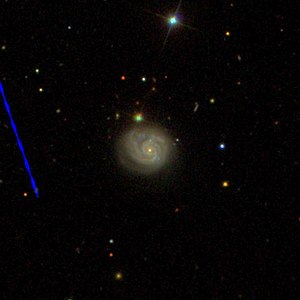NGC 5265
| Galaxy NGC 5265 |
|
|---|---|

|
|
| SDSS | |
| AladinLite | |
| Constellation | Hunting dogs |
|
Position equinox : J2000.0 , epoch : J2000.0 |
|
| Right ascension | 13 h 40 m 09.1 s |
| declination | + 36 ° 51 ′ 40 ″ |
| Appearance | |
| Morphological type | SBcd |
| Brightness (visual) | 14.2 mag |
| Brightness (B-band) | 14.9 mag |
| Angular expansion | 0.7 ′ × 0.6 ′ |
| Position angle | 66 ° |
| Surface brightness | 13.1 mag / arcmin² |
| Physical data | |
| Redshift | 0.019112 +/- 0.000091 |
| Radial velocity | 5730 +/- 27 km / s |
|
Stroke distance v rad / H 0 |
(259 ± 18) · 10 6 ly (79.3 ± 5.6) Mpc |
| history | |
| discovery | Wilhelm Herschel |
| Discovery date | May 1, 1785 |
| Catalog names | |
| NGC 5265 • PGC 48354 • CGCG 190-040 • MCG + 06-30-068 • IRAS 13379 + 3706 • KUG 1337 + 371 • 2MASX J13400908 + 3651396 • GC 3630 • H III 410 • h 1659 • NVSS J134008 + 365137 | |
NGC 5265 is a 14.2 mag bright bar-spiral shaped radio galaxy of the Hubble type "SBcd" in the constellation Hounds in the northern sky . It is estimated to be 259 million light years from the Milky Way and about 55,000 light years in diameter .
The object was discovered on May 1, 1785 by Wilhelm Herschel with an 18.7-inch reflector telescope, who described it as "vF, S, lE, easily resolvable".
